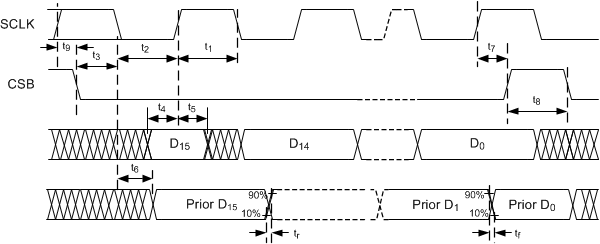SNAS648C October 2014 – February 2023 TDC1000
PRODUCTION DATA
- 1 Features
- 2 Applications
- 3 Description
- 4 Revision History
- 5 Pin Configuration and Functions
- 6 Specifications
- 7 Parameter Measurement Information
-
8 Detailed Description
- 8.1 Overview
- 8.2 Functional Block Diagram
- 8.3 Feature Description
- 8.4 Device Functional Modes
- 8.5 Programming
- 8.6 Register Maps
- 9 Application and Implementation
- 10Device and Documentation Support
- 11Mechanical, Packaging, and Orderable Information
6.6 Timing Requirements
TA = 25°C, VDD = VIO = 3.7 V and
ƒSCLK = 1 MHz (unless otherwise noted).
| MIN | TYP | MAX | UNIT | |||
|---|---|---|---|---|---|---|
| ƒSCLK | Serial clock frequency | 26 | MHz | |||
| t1 | High period, SCLK | 16 | ns | |||
| t2 | Low period, SCLK | 16 | ns | |||
| t3 | Set-up time, nCS to SCLK | 10 | ns | |||
| t4 | Set-up time, SDI to SCLK | 12 | ns | |||
| t5 | Hold time, SCLK to SDI | 12 | ns | |||
| t6 | SCLK transition to SDO valid time | 16 | ns | |||
| t7 | Hold time, SCLK transition to nCS rising edge | 10 | ns | |||
| t8 | nCS inactive | 17 | ns | |||
| t9 | Hold time, SCLK transition to nCS falling edge | 10 | ns | |||
| tr / tf | Signal rise and fall times(1) | 1.8 | ns | |||
(1) The slew rate is measured from 10% to 90% and is represented by
the average of the rising and falling slew rates.
 Figure 6-1 SPI
Timing Diagram
Figure 6-1 SPI
Timing Diagram